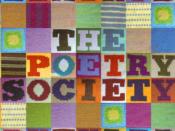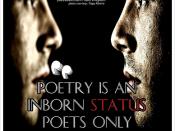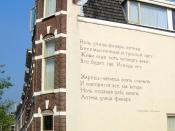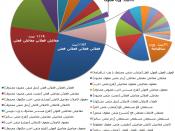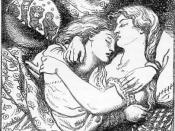The Good, The Bad, and The Poetic (An analysis and evaluation on ?Little Boy Blue? and ?The Toys?.) What is a ?good? poem? Or what makes a poem ?bad?. There are no specific rules or guidelines to writing a poem. It is easy to form an opinion of what is good or what is bad on two different poems for an individual, but to be able to make informed judgments and for these judgments to be accepted as good or bad, universally, takes a bit more of an in-depth insight. In this analysis and evaluation of ?Little Boy Blue? and ?The Toys?, one will be able to understand what makes them either good poems or bad poems by the writers? usage of diction, images and figure of speech, details, and the poems general impression. As well, it will incorporate that both poems are sentimental but differ in their appeal to a beginning reader and a more mature reader.
There are three basic questions that one must follow in judging a poem or poems. What is the poem?s central purpose? In ?Little Boy Blue? the purpose of this poem is in a loved one?s death, the ones? who loved them will always remain longingly and true. The central purpose of ?The Toys? is before one takes out their aggression on a child, remember that a child is good and seeks goodness. One will regret excessively punishing a child for committing childish things. Secondly, how fully has this purpose been accomplished? ?Little Boy Blue? and ?The Toys? both accomplish their purpose through the list above in the previous paragraph. However, ?Little Boy Blue? attracts less inexperienced poem readers because of the simpler yet powerful diction that is used. ?The Toys? draws a mature poem reader do to a higher level of diction but at the same time is clear as well as powerful to that reader. Lastly, how important is the purpose? In both poems the purposes are both sentimental, again depending on the readers? poetic experience level, and they are moving and intense giving the poems a better and a more powerful central purpose. These are the first steps used in making informed judgments for the two poems in deciding whether they are ?good? or ?bad?.
In the following paragraphs, one will see that using these methods are incorporated and built around the central purpose of each poem. Using these methods helps one use insight for making respectable judgments. Also, they will begin to unveil the poems? ?goodness? or ?badness? in a sort of checklist-type manner.
To begin the ?checklist? one can look at the poems? diction. Are the words not entirely too difficult to understand, but are they still powerful enough to portray the central purpose? As for ?Little Boy Blue? a reader can obviously see that the diction is fairly simple, yet still strong enough to captivate a strong, sentimental purpose. A beginning reader can clearly understand what is meant, for example, when the author writes, ?So, toddling off to his trundle-bed, he dreamt of the pretty toys??(Lines 11, 12). In ?The Toys? a beginning reader may have a slight amount of trouble understanding the poem?s upper level diction, but for a moderate or experienced reader, the diction is quite arresting, powerful, and precise giving the central purpose better comprehensibility. In lines 10 and 11, ?With darkened eyelids, and their lashes yet from his late sobbing wet?, the experienced reader can obviously tell the boy cried himself to sleep. However, this may be a little more obscure for the novice reader. Although the poems appeal to the different levels of readers, one can argue that they both get a check mark for ?good?.
A poem?s images and figure of speech can be crucial in what makes a poem ?good? or ?bad?. Images and figure of speech, or the lack thereof, can bore a reader and take away from the importance of the central purpose. ?Little Boy Blue? nor ?The Toys? has this problem. ?And the soldier passing fair?? (Line 7), in ?Little Boy Blue? gives a great visual and a fresh way of being written describing the toy?s aging. Also, another good visual and figure of speech is in ?The Toys? when said, ?Ah, when at last we lie with tranced breath?? (Line 24), to describe a deep sleep. Both poems, again, convey another element of a ?good? poem.
Details in a poem can either ?make or break? it. Too many details can become overbearing and distract the reader from the central purpose. Too few details can take away from the poem?s general impression, again, stealing from it?s central purpose leaving it diffused and bland. In ?Little Boy Blue? the poet uses compressed but well-chosen and purposeful details describing Little Boy Blue?s lifelike but aged toys. Although the poet?s details are not in the masses and not too wordy, they are well thought and enough not to diminish it?s general impression. The poet of ?Little Boy Blue? does an outstanding job of not stripping the poem of it?s general impression, maintaining the poem?s dignity of being compressed, intense, and moving. As opposed to ?Little Boy Blue?, ?The Toys? could be criticized for too many details when mentioning the child?s ornaments or ?toys? on the bed stand in lines 16 through 20. However, the items being described help intensify the poem?s general impression showing that those are not just toys to the child but rather objects of his affection to comfort him when he is sad. ?The Toys? poet, also, does an excellent job by using plentiful and purposeful details. Both poems after being openly, honestly, and critically evaluated, can be added an additional two checks for ?good? due to having good details and good general impressions.
In conclusion one has been able to establish that ?Little Boy Blue? and ?The Toys? are ?good? poems by using the methods that have been previously listed. Also, both were noted to be sentimental and only vary in others? opinions of ?good? or ?bad? by the different levels of reading. It is not always easy to be insightful or make respected informed judgments. It is the distinction between the educated person and the ignorant one in that gives the ability to do so (Perrine?s Literature, p. 799). Everyone has their own opinions, their own views of what is quality poetry and what is poor poetry. Until one is able to take an in-depth insight he or she?s opinion will never be upheld or respected.
